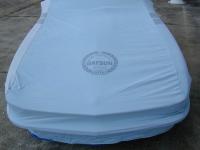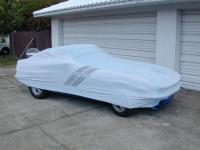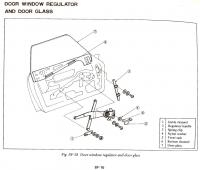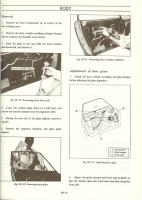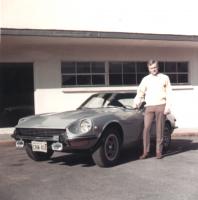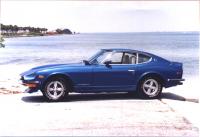Everything posted by Carl Beck
-
BRE 240Z Medallions
Hi Chris / Goose52 everyone: I agree - the Ad. lines during the transition from BRE to INTERPART, put out by BRE was "Now We Are INTERPART".. and to everyone's mind the BRE Parts Business was INTERPART and vis versa. BRE stuff was BRE stuff no matter if you bought it from BRE or later INTERPART. As Chris correctly pointed out - MULHOLLAND stuff was not BRE stuff... INTERPART was started so that the BRE Shop could focus on racing and not spend so much time shipping BRE Parts. I'd have to check with Mr. Brock, but I believe that when InterPart was first formed, Mr. Brock held a 30% or 40% interest in Interpart, and his primary interest was to continue the BRE Parts Sales (and associated income).. while off loading the Parts Business work - from the Racing Shop. In the original agreement between Nissan and BRE, the Nissan Authorized Dealers would sell BRE Parts via their Datsun Parts Dept.'s and BRE could market Nissan Competition Parts via BRE. BRE for example sold a slightly re-designed Nissan Rear Spoiler, that was fabricated locally for BRE. BRE's Competition Oil Pump Springs - were another example of Nissan Parts re-branded and sold as BRE parts. As the InterPart business grew - it required more employees, more investment in inventory, and more capital to have additional items produced so they could be added to the line up - like the BRE Headlight Covers, BRE Car Covers etc. So additional investments were made by the other partners and Mr. Brocks' ownership in terms of the percentage of the business was diluted to much less than the original 30% or 40%.... Also BRE shut down around the end of 1973 or in early 1974.... Any business needs growth - and the Mulholland Brand started to fill that need for growth..as well as things like the Shadow Shade Kits etc. BTW - My BRE Z Car Cover, purchased before Dec. of 71 - does have the same commemorative wreath that Goose52 has on his Bra.. I think I still have the same BRE Bra somewhere out in the garage as well. I know I purchased the car cover before the end of Dec. 71 - because I had to park my 240-Z in the hangers at the Air Base and I wanted it covered, as I was TDY to SEA. FWIW, Carl B.
-
BRE 240Z Medallions
Hi Wayne: 137 Oregon was the BRE Shop/Parts 141 Oregon was the first Interpart Building 100 Oregon was the second Interpart Building So the fire must have been 2/72 and 8/72.... FWIW, Carl B.
-
Passenger side door window..See photos
-
another question.... starters?
...... because the starter engages the Ring Gear on the Flywheel - has nothing to do with whatever standard transmission you have. FWIW, Carl B.
-
BRE 240Z Medallions
Hi Goose52: I was thinking that by 72 - the Parts Counter would have been at Interpart. At any rate - the original run of 510 Badges and Medallons were lost when the Interpart shop burned... and they moved to a newer location and reopened. I'm thinking that was around 74 or so... You wouldn't happen to have any pictures of the original BRE Shop would you? Carl B.
-
Roof racks for a Z
Hi Mike: Yes - that's the one. I think it's the same seller I bought mine from too. There was also an accessory that converted or utilized the Roof Rack as a Ski Rack. Carl B.
-
BRE 510 on Ebay ?
Hi Guys: First let me say that I believe any DATSUN 510 with a documented 7K original miles and a rust free body is worth at least the current bid and perhaps far more... I haven't seen a 510 on the streets here in Florida for at least the last ten years... and I know there are tens of thousands of people that love the 510's. I believe that Mr. Brock even owns a 510 today.(being highly mod'ed out). Reviewing what Mr. Kohs has written - When Mr. Kohs refers to "we" - I get the distinct impression that at the time and today - he feels he was part of the over-all NISSAN/ DATSUN BRE team. It would seem that "The Marketing Corporation of America" worked for NISSAN/DATSUN USA and with the BRE Team as well as with the DATSUN Competition Dept. Ron reports that Gary did "some work promoting BRE" - - My understanding is that Gary Kohs (Marketing Corporation of America) acquired the SIMONIZ sponsorship for BRE, got Revell to do a promotional model of the BRE 510 and associated advertising etc. plus a lot more {as Gary states in his E-Bay write-up}. So his involvement was more on the major side of things, than a minor bit player....(money is a very important part of racing and Marketing is the primary driver for sponsorships). He also stayed with NISSAN/DATSUN after BRE folded... and kept the SIMONIZE sponsorship for Jim Conner's successful campaign of the Datsun Pick-up's, prepared by Bill Stroppe, at the Baja. (June 74 Issue of the DATSUN NEWS). Given Mr. Brocks conflicts with the people at Datsun Competition I can understand his displeasure with Mr. Kohs. It will be interesting to see if Mr. Kohs comes up with invoices for work done on the car at BRE. He said they installed a 5spd, race suspension, mild engine mod.'s and American Mags..etc. The bottom line is - the seller has more than sufficient documentation to prove his, and this 510's ,"association" (good or bad) with both Nissan/DATSUN USA and BRE... Failed project or not... it's part of the history associated with the over-all story. So I would think that any serious BRE collector would place some premium, over and above the value of most other regular production 510's - on this one. Just my perspective... but a lot of the value of any collector car is found in it's documented history and the interesting stories surrounding them. FWIW, Carl B.
-
Vin
Hi Jerry/Arne: Arne is correct - VIN's between HLS30 91591 and 95904 were all built 07/72. Your original engine serial number - from the Data Plate under the hood - should be between L24-113xxx and L24-120xxx. You can order a new VIN Plate for the Drivers Door Jam from <a href=http://www.zzxdatsun.com TARGET=NEW>Banzai Motorworks </a> FWIW, Carl B.
-
long and short pig tail fuse boxes..whats the dif?
Hi Arne: It would seem to be so... The good news was they were now switching the power.... but the bad news was they were still running the full power though the switch... instead of using the switch to toggle a relay. Even that wouldn't have been so bad - if it was only the headlight switch... but the Combination Switch was complex and EXPENSIVE... not to mention the Fuse Box itself destine to melt down...
-
long and short pig tail fuse boxes..whats the dif?
According to the Service Bulletin - for the Series II Datsun 240-Z on US and Canada cars. - - - quote - -- - The head lamp harness has been changed from the previous design. The dual system circuit now includes a battery switch in place of the former ground switch to prevent electro-chemical attachment on the lamp terminals while the switch is left "OFF". In accordance with this improvement, the head lamp cover has been eliminated on USA and Canada models. Affected Changes Fuse block ...... Internal connection changed (one lead wire added to harness) Light Switch.... One lead wire added to harness Harness.... Instrument and heater circuits changed Combination switch Head lamp and wiper - ground circuits have been separated. As the result, one lead wire has been added to the harness. - - - end quote - - - - Looking at the schematics..... For the Series II cars - there is one additional Red Wire running between the fuse block and the combination switch. All other connections and fuses are the same. So it would seem that you can use the newer fuse block - in the older cars.... but you couldn't use the older fuse block in the newer cars. FWIW, Carl B.
-
long and short pig tail fuse boxes..whats the dif?
Hi Chris (everyone): My Parts Fiche shows: 25410-E4600 Assy Fuse Block "Up-To" 12/70 25410-E8300 Assy Fuse Block "From" 01/71 25410-E8800 Assy Fuse Block "Up-To" 07/73 As I understand it - that means that the E8300 number could have been superceded at any point between 01/71 and 07/73 by the E8800 number. {"Up To" gives you the end date - where "From" provides the start date} 25410-N3600 Assy Fuse Block "From" 08/73 Would mean that the E8800 number was replaced with N3600 starting as of 08/73. I don't show any E8600 number (25410-E8600) My Fiche is as Revised "December 1979".... FWIW, Carl B. Clearwater, FL
-
Pic request of Butterscotch Z's....... And our pix. Take a look!!!!!
HI Keith: Silver is one of my favorite colors on the 240-Z. It highlights the beautiful lines of car. If you and your Father are going to do a full color change - and a full "refresh" or even a full "restoration" on the Z - I'd paint it any of the original colors you want. While many have a point about retaining the Gold car in it's current "original" condition - I'm betting that upon close physical inspection, the original paint isn't all that great today... and it's really is time to replace it. Your Fathers Yellow 240-Z looks great... Good luck, Carl
-
Another nice yellow one on Ebay
Hello Everyone: The seller had to relist the car - corrected the VIN # listed and dropped the offer to take "trades" as e-bay doesn't allow trading.. Search for new Item number: 150105356624 FWIW, Carl B.
-
Another nice yellow one on Ebay
I have written the seller to inform him that the Florida DMV did indeed have a computer error induced during some transition of records from one system to another in the early 90's... So if it is a mistake, then the car is very reasonably priced at the Buy-it-Now for $8K - for this area of the country... (if it checks out otherwise) 1971, with 71K original miles, present and previous owners known... If it checks out under the car (frame rails and floorboards - area under the battery etc).... it would be a good buy for anyone that is looking for a nice driver. Better to pay an extra couple of grand - if the car is in your area and you can check it out completely before you buy - than to bid on a cheaper car located across the country... All the above said - it is still up to the seller to provide "good title" , unless the buyer agrees to accept the car with a Salvage/Rebuilt title... (which might be acceptable if the price was cut in half for example). Carl B.
-
engine oil selection
Red Line's Water Wetter is a surfactant with the necessary anti-corrosives and water pump lubricants found in permanent Summer Coolants/Anti-Freeze. A surfactant breaks down the surface tension of a liquid and thus allows the molecules of the water to come into closer contact with the metal surfaces over which it is flowing. In turn this allows the water to pick up more heat from the engine, and it allows the water to pass off more heat when in the radiator. Most major automotive parts stores carry it today.. FWIW, Carl B.
-
Another nice yellow one on Ebay
Missed the "REBUILT" title perhaps??? Carl B.
-
engine oil selection
I run Mobile 1 10-40 because it will reduce engine operating temperatures 10 to 15 degrees here in Florida. I also run Red Line Water Wetter and water in the radiator - because it will reduce engine operating temperatures 10 to 15 degrees here in Florida. These two things make the difference in stop and go traffic between seeing the temperature gauge approaching HOT or staying in the middle (normal) in the summer months. FWIW, Carl B.
-
Pain in the Rear(end)
It of course depends on how far it was driven with low to no gear lub - and/or how hot it got. But with only 80K miles on the car - it should be fine if you refill it. Take the back cover off - so you can put it in a vise. Take a butane torch and heat the area round the fill and drain plugs - both inside and outside surfaces - then put a "Pipe" or "Monkey" wrench on the external plug (can't recall if the fill plug or drain plug sticks out).... It's a standard Pipe fitting and a pipe wrench will grip it firmer as you apply torque. Put a light coating of anti-seize on the threads before you reinstall the plugs... FWIW, Carl B.
-
Extended Oil Life Guidelines - 7,500miles
Thinking about it.... Back in 1962 I had an Oldsmobile StarFire Convertible. The recommended oil change interval was 3,000 miles or 3 months. That beauty got about 8 mpg around town and it would deliver about 13 to 14 mpg on the highway. At 8 mpg - that engine would pump through about 375 gallons of leaded gasoline and it's associated air in that 3000 mile distance. At 14 mpg that's about 214 gallons of gasoline.. Of course we change oil not so much because it wore out - but because it becomes contaminated while circulating within the engine. Unburnt fuel, carbon deposits from combustion and even the lead from the fuel all contaminated the oil and reduced its ability to lubricate the moving parts of the engine. Today - as the article states - automotive lubricating oils are far superior to the one's used 45 years ago. Plus that HHR should be getting at least 18 mph in town and 25 or 26 on the highway. At 18 mpg the engine in the HHR will pump about 167 gallons of gasoline and its associated air through that engine. That's about 55% less for in town driving... and 120 gallons of gasoline for the same highway use or 44% less at highway speeds.. Even without considering the vast improvements in lubricating oil technology over the past 45 years, as well as the elimination of Lead Contamination from the fuels - it makes perfect sense to me that 6,000 or even 7,500 mile oil change intervals are perfectly well suited to todays cars.. Nonetheless, I'll maintain the 3000 mile change interval for my 240-Z's.... as they are at least 35 year old cars now.. FWIW, Carl B.
-
Extended Oil Life Guidelines - 7,500miles
Just FYI - DETROIT - Most major automakers agree: The adage that you should change your car‚s oil every 3,000 miles is outdated, & even 5,000 miles may be too often. FoMoCo became the latest manufacturer to extend its oil life guidelines, making public that it is raising the recommended oil change interval from 5,000 miles to 7,500 on its newly redesigned '07 models & all subsequent redesigned or new models. The company, like many other manufacturers, said Tuesday that higher oil quality standards & new engine designs were responsible for the change, which affects vehicles driven under normal conditions. „The oils have advanced a lot since the days when 3,000 miles were the typical oil drains,‰ said Dennis Bachelder, senior engineer for the American Petroleum Institute, an industry organization that sets quality standards. „They‚re certainly more robust than the oils of 10, 15 years ago.‰ These days, motor oils start w/a higher-quality base oil than in the past, & they have more antioxidants that make lubricating properties last longer & other additives that keep deposits from forming on engines, Bachelder said. Pete Misangyi, Ford‚s supervisor of fuel lubricants, said the company conducted numerous fleet & laboratory tests w/newer oils before it raised the interval. „That allows more comfort, if you will, in extending the intervals using the new oils,‰ he said. Some manufacturers, such as Honda & GM, have stopped making recommendations on all or most of their models, instead relying on sensors that measure oil temperature extremes & engine revolutions over time to calculate oil life & tell drivers when to get the lubricant changed. Oil can lose its lubricating properties if it runs at too low or too high of a temperature. Peter Lord, executive director of GM‚s service operations, said oil can last 12,000 miles or even more for many drivers who don‚t run their vehicles in extreme heat or cold or tow heavy loads. „It really does depend on the individual customer & how they‚ve used the vehicle,‰ he said. Ford said it has found that its customers like a set mileage for service rather than wait for a sensor to tell them what to do. For those who don‚t believe the sensors, Lord says GM has reams of data showing that they‚re reliable, & they notify drivers far in advance of when a change is necessary. „We are absolutely confident of the technology. We back it w/a 100,000 mile powertrain warranty now, so there‚s no doubt in our mind that this technology works,‰ he said. The longer oil life can save customers money. Ford estimates that drivers would save $600 over a 5-year period by going from 5,000 miles to 7,500 between oil changes. „From an environmental perspective we can save an enormous amount of oil,‰ Lord said. „There‚s no point in wasting precious oil changing it prematurely. And we don‚t have to dispose of so much waste oil, either.‰ When to change oil is not w/out controversy, tho. Toyota reduced its change interval from 7,500 miles to 5,000 in '04 in part because it found that more drivers ran their vehicles under severe stop-&-start & short trip conditions that cause oil to deteriorate more quickly, said company spokesman Bill Kwong. Toyota also had an oil sludge buildup problem on less than 1% of its '97-'02 model year vehicles, Kwong said. Changing the oil more frequently prevents the sludge problem, which he said was caused by owners going more than 7,500 miles before changing oil. The company lengthened warranty coverage on the affected engines to handle the problem, even before some owners filed a class action lawsuit, Kwong said. Nissan recommends changing oil in its Nissan & Infiniti vehicles every 7,500 miles or 6 months ˜ unless the vehicle is used mainly for towing, trips of 5 miles or less in normal temperatures, 10 miles or less in freezing temperatures, stop-&-go driving in hot weather or low-speed driving for long distances, in which the oil should be changed every 3,750 miles or 3 months, spokeswoman Katherine Zachary said. And for some engineers & mechanics, 5,000 miles is too long to wait. Drivers must take the weather & how much freeway driving they do into account before deciding when to change their oil, said Danny Beiler, part owner of an auto repair garage in Sarasota (FL). Freeway driving is less harmful to oil than driving in the city, but in Sarasota, the heat places nearly all cars under severe driving conditions that warrant more frequent changes, Beiler said. „I have a problem w/telling people 7,000 because you know they‚re going to go over that. I‚d rather err on the side of being cautious & tell them to do it early.‰ Dewey Szemenyei, marketing manager for passenger car motor oil additives for Afton Chemical Corp., said he still changes the oil in his '98 Toyota Sienna minivan every 3,000 miles. „I really feel it‚s great insurance,‰ said Szemenyei, whose company makes additives that go into motor oils & who chairs an SAE committee on engine lubrication. „There‚s not what I consider a right answer. However, if you go w/the owner‚s manual recommendation you should in general not have any problems,‰ he said.
-
just wanted to see how old everyone is here?
62 years, 6 days, 11 hours and 5 minutes.... as of 10:55 EDT Carl B.
-
72 on ebay
Hi Sailor: Just so I'm sure we are talking about the same condition definitions for vehicles... I've copied/pasted the Kruse Value Guide Definitions below. A nice #2 condition 240-Z as outlined by Kruse - would sell today for $25K or more. Granted one might run across a distressed seller - that needed fast cash - and pick up a true #2 condition car for $15k to $18K... but that's a matter of luck and you don't see it happening too much now. I do agree - I'd sure be a buyer for any #2 condition 240-Z at $15K IMHO - the best bargain in a new sports car now is the Pontiac Soltice GP-X - turbo with 260HP in a 2800lb roadster - for $28K... hard to beat. However every year that new car will depreciate - while that old Z will be appreciating and that is the MAJOR difference... besides the Z is still far more attractive and offers far more utility - not to mention just plain fun to drive... FWIW, Carl B. Keep in mind these are condition definitions for CLASSIC CARS! .. not just 240-Z's in their current use.. #1 EXCELLENT - Restored to current maximum professional standards of quality in every area, or perfect original with components operating and appearing as new. A 95+ point show car that is not driven. In national show judging a car in #1 condition is likely to win top honors in it's class. In a sense it has ceased to be an automobile and has become an object of art. It is transported to shows in an enclosed trailer, and, when not being shown it is stored in a climate controlled facility. It is not driven. There are very few #1 cars. #2 FINE: - Well-restored, or a combination of superior restoration and excellent original. Also an extremely well maintained original showing very minimal wear. Except for the very closest of inspection a #2 vehicle may appear as a #1. The #2 vehicle will take the top award in many judged shows, except when squared off against a #1 example in its own class. It may also be driven 800 - 1,000 miles each year to shows, on tours, and simply for pleasure. #3 - Very Good: Completely operable original or "older restoration" showing wear. Also, a good amateur restoration, all presentable and serviceable inside and out. Plus combinations of well-done restoration and good operable components; or a partially restored car with all parts necessary to complete it and/or valuable NOS parts.
-
72 on ebay
Hi Jerry: Agreed - documentation on the miles, via State Vehicle Inspections, Service Invoices over time etc. would be an important part of the deal. This is supposed to be the original owner as well - so original bill of sale, window sticker, Service/Warranty Card etc would also be expected to be on hand. My advice to the seller - via the friend of the friend.. was to NOT ATTEMPT, NOR ALLOW ANYONE ELSE TO ATTEMPT to start the car. That should only be done by the future owner. Have some yahoo crank that car over and it could do very serious and expensive and time consuming damage at this point. I believe that any serious buyers - would want to wake this sleeping beauty up in a very methodical and careful manor. Done right, given the States in which the car had been stored - it would be good as new again. Done wrong - and you'd have a prolonged mess on your hands... Fly out there and inspect the car (round trip in a day is easy from your location) - if it checks out completely - Send a truck to pick it up - Air the tires up - push it on a trailer... and bring it home.... What the hell - there is no real difference between $12K and $13K in todays dollars - that's like $1,200.00 or $1,300.00 when the car was new!! If there is anything that turns out to be NOT as represented.. offer the seller a reasonably reduced amount of CASH on the spot... FWIW, Carl B.
-
72 on ebay
Hi Sailor Bob (everyone): I'd say that someone believed that the car "could be put in pristine condition." Put in #2 Condition - an all original 72 240-Z, with documented 37K miles - will sell in the $25K range. I know of at least three that have traded hands within this past year at these levels. My advice to a local person, who knew the person that was handling the sale - was at most the car was worth $12K as it sat (and if no attempt to get the car running was made). Then he could plan to spend a year and another 4K or $5K to put the car in the shape it should be. That assumed that the paint was still in good condition and could be simply cleaned up and polished, the undercarriage was fine etc. So for $16K or $17K and a lot of work - he'd have a very nice, very original and very low mileage 72. I think the seller has been offered top dollar for the car as it currently sits... Interesting interview in the Hagerty's Volume 2, Number 1 "Block Party" Page 19. Speaking about the future of the Collector Hobby - Donald Osborne says: ,,,,,, "Another trend is the newfound interest in "original" cars. Unrestored cars have become more desired as there's no going back once they have been altered. Once, if a collector had a very original car, it was viewed merely as the starting point for a full restoration. Now that same owner is challenged not to touch it at all. There is a growing gap between historic cars that have undergone full restorations - - or cars that are well-preserved and documented original condition - - and more common cars with needs. This is true at all levels of collecting from common English sports cars to major classics, but it is especially seen at the top end." and: "Now that they are getting rarer and harder to find, original cars are even more appreciated" says David Gooding. "People are realizing that shinny isn't always the best. The cars that have never been touched have a lot to say." FWIW, Carl B.
-
Your first Z car...
I was 25 when I bought my first 240-Z in March of 1970. A Silver beauty HLS30 01777. Then bought my Metallic Blue 72 in Dec. of 71, which I still have. Oh... that last picture was taken at about 125mph in the AZ outbacks.. by my first wife. FWIW, Carl B.




